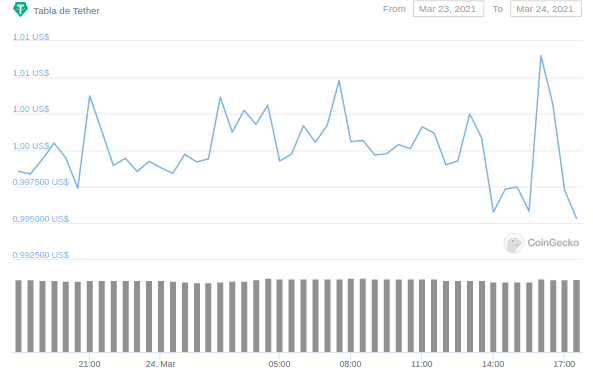The most traded stablecoin on the market, Tether, surpassed $40 billion in market capitalization on Wednesday, while William Quigley, co-founder of the stablecoin, calls for audits at least once a month.
Tether (USDT) Tether reached a value of $1,02 per unit on Wednesday, pushing its market cap to above $40 billion. With a current circulation of 39.920.510.120 USDT tokens, Tether reached $40.718.920.322 ($40.718 billion) in market cap.

Source: CoinGecko
Despite the conflicts it has faced, and still faces, Tether is the most used and transacted stablecoin on the market, with a dominance of almost 70% in the stablecoin sector.
Demand for this stablecoin continues to grow. To date, Tether handles a daily trading volume that even exceeds Bitcoin, cryptocurrency largest and most important by market cap. USDT transactions are above $80 billion per day, while Bitcoin's daily transaction volume is around $60 billion.
At the time of writing, the value of USDT fell by 0,7%, bringing the price of the coin back to $1 per unit. Despite the drop, Tether remains the third-largest coin in the industry by market cap, ranking above Binance Coin (BNB) and Cardano (ADA), which until recently was ranked as the third-largest cryptocurrency in the market by market cap.

Source: Coin Market Cap.
Furthermore, the data from Messari show that Tether’s market cap still remains above $40 billion at the time of writing.
It may interest you: Tether, the largest and most used stablecoin in the world, is banned in New York
10x growth in one year
On its Twitter account, the company responsible for the development of Tether, Tether Limited, noted that the stablecoin's market capitalization has grown 10-fold in the past year, establishing itself as the largest and most important asset in this sector of the crypto industry.
Tether Limited notes that as of March 2020, exactly one year ago, USDT's market cap was just $4 billion, so its annual growth has been between 900-1000% over the past 12 months.
The growth of this currency is a sign of the interest and adoption of digital assets by the crypto community, although Tether is not exempt from doubts and uncertainty on the part of users.
Scrutiny by regulators
In late February, Tether Limited faced off against New York state regulators, who issued a cease and desist order on all trading activity with the currency within New York territory. The New York Attorney General's decision responds to allegations that Tether has failed to comply with and violated laws by hiding millions in losses and essential financial information from its investors, users and regulators.
However, the New York regulator and the company reached an agreement, where Tether must pay a fine of $18,5 million. The agreement has managed to dispel much of the uncertainty surrounding the value of USDT in the crypto community. On the other hand, although the ban in the state of New York was believed to be an element that would collapse the value of Tether, due to the lack of clarity and audits pointed out by the regulator, and which probably demonstrated the lack of physical reserves to back the entire value of USDT in circulation, the value of the stablecoin remained firm.
Another element that is favoring the use and adoption of Tether is the arrival of the second layer protocol Hermez network; a protocol designed to scale Ethereum, which integrates with Tether, to ensure fast and cheap transactions with the currency. In an announcement on Wednesday, the developers reported that the protocol is now active on the Ethereum mainnet. Also, the arrival of the stablecoin to the blockchain Solana's is a point in favor of its adoption.
Constant audits
William Quigley, co-founder and former executive of Tether Limited, noted that the company and the currency's physical reserves must be audited at least once a month. During an interview on CoinDesk TV, Quigley said that the stablecoin must maintain a transparent issuance, and move away from the opacity it has been associated with since its launch.
“Every time a Theter is printed, a dollar should be added to that pooled account… it should be audited at least once a month, once a quarter.”
According to the company’s general counsel, Tether is preparing new instruments to ensure the transparency that regulators demand and that the crypto community deserves. Tether will reveal these new instruments in due time, the executive noted.
Continue reading: Hermez Network, the solution that Tether implements to reduce its transaction cost




